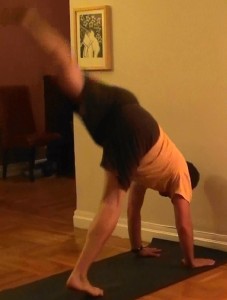 If I were ever (and of course I would never) to teach triangle on only one side a chorus of students would begin to howl about the injustice that was occurring.
If I were ever (and of course I would never) to teach triangle on only one side a chorus of students would begin to howl about the injustice that was occurring.
Oddly, never once has anyone ever complained that I only taught handstand from one leg.
The way I usually teach handstand is at the wall and from Downward Dog.
From there I tell students to step one foot in, whichever one they want, and that is usually the right choice from the standpoint of getting up.
Lately, I have been working hard to remember to also do the other leg.
I am not sure why this isn’t as important to me as it should be but in the same way that students don’t complain, there is some sort of brain freeze about doing handstands with both legs.
And I think it is actually as important if not even more important to do a handstand with both legs than it is to do triangle pose on both sides.
Handstands are way more active, working the hips more, and only doing one leg is far more likely to increase our imbalances than a standing pose.
There is a tendency in the handstand to let the hip of the lifting leg fly open which takes us out of the core and stops the psoas muscle from helping the spine find its way aloft.
If we are only doing this on one side and doing it badly I would prefer if it was done poorly on both sides.
First learning handstands can be one of the most aggressive parts of a yoga practice.
As much as it would be good to exhibit patience and take one’s time to go up with ease and grace, all too often students hurl their bodies at the wall in order to try and get up.
And sometimes I even encourage them to do exactly that in the hopes that they might make it.
Doing handstands successfully can be very empowering but working on doing them with both legs is just a smart way to practice.
From now on (I hope) I will always be insisting that students work both sides when going up into handstands.
